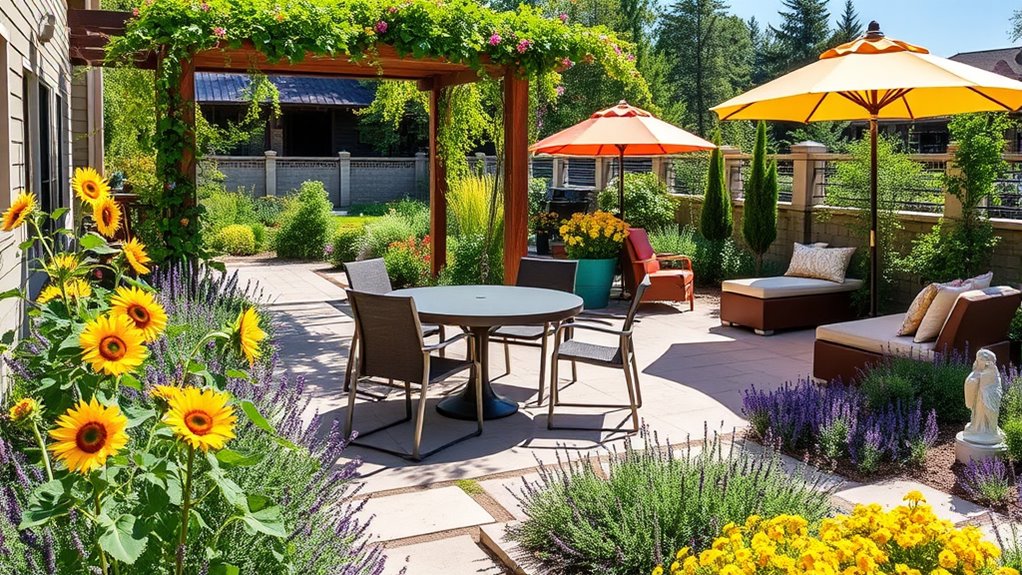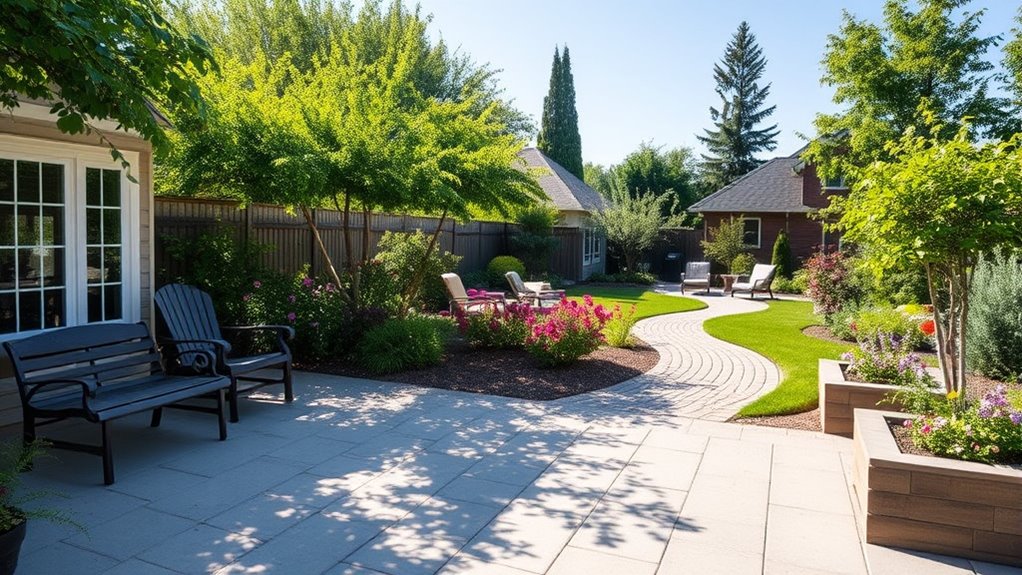Designing inclusive patios and gardens means creating spaces that everyone can enjoy, no matter their sensory or mobility needs. You can incorporate sensory landscaping with fragrant plants, textured surfaces, and water features to engage multiple senses. Use adaptive furniture that’s versatile, supportive, and easy to access, like adjustable tables and comfy seating. Clear pathways and tactile cues also help navigation. If you keep exploring, you’ll discover more ways to make outdoor environments welcoming and accessible for all.
Key Takeaways
- Incorporate sensory landscaping elements like fragrant plants and textured surfaces to engage diverse senses and promote calming experiences.
- Use adaptive furniture with versatile support, adjustable heights, and weather-resistant materials for inclusive comfort.
- Design clear, smooth pathways to ensure easy navigation for all mobility levels and reduce accessibility barriers.
- Strategically place sensory features and accessible seating to encourage exploration, social interaction, and comfort.
- Consider vibrational energy and environmental cues to create positive, inclusive atmospheres that enhance sensory and emotional well-being.

Have you ever struggled to find outdoor spaces that are welcoming and easy to access? If so, you’re not alone. Many outdoor areas can feel intimidating or inaccessible, especially for those with mobility challenges or sensory sensitivities. To create truly inclusive outdoor spaces, designers are turning to innovative solutions like sensory landscaping and adaptive furniture. These elements make patios and gardens more inviting and functional for everyone, regardless of their physical or sensory needs.
Creating inclusive outdoor spaces with sensory landscaping and adaptive furniture benefits everyone.
Sensory landscaping involves thoughtfully incorporating plants, textures, and elements that stimulate the senses in a positive way. You can imagine walking into a garden where the air is filled with fragrant flowers, textured leaves, and the gentle sound of water features. By choosing a variety of plants that appeal to different senses, you create an environment that is both engaging and calming. For example, rough-textured bushes, fragrant herbs like lavender, and visual contrasts with vibrant colors all contribute to a sensory-rich experience. This kind of landscaping not only caters to those with sensory processing differences but also enhances the overall atmosphere, making outdoor spaces more lively and engaging for everyone.
Adaptive furniture plays an essential role in making patios and gardens accessible. Instead of standard benches or tables, consider furniture designed with versatility and comfort in mind. You might opt for chairs with armrests that provide support, tables at different heights, or sturdy, stable seating that accommodates wheelchairs or walkers. Adaptive furniture reduces barriers by ensuring that everyone can comfortably sit, rest, and enjoy the outdoor environment. It encourages longer visits and more interaction, fostering a sense of inclusion and community. Plus, choosing durable, weather-resistant materials ensures that the furniture remains functional and safe over time.
When you combine sensory landscaping with adaptive furniture, you create an outdoor space that’s not only accessible but also rich in sensory experiences. Clear pathways with smooth surfaces allow easy navigation for wheelchairs and walkers, while thoughtfully placed sensory elements invite exploration. Seating options that are easy to get in and out of, along with tactile and visual cues, make the space welcoming for individuals with a variety of needs. Accessibility isn’t just about meeting standards; it’s about designing environments that genuinely invite everyone to enjoy the outdoors. By focusing on sensory landscaping and adaptive furniture, you help transform ordinary patios and gardens into inclusive retreats that everyone can appreciate and feel comfortable in.
A key aspect of designing accessible outdoor spaces is understanding the importance of vibrational energy and how it influences our experience of the environment.
Frequently Asked Questions
How Can I Incorporate Sensory Elements Into Outdoor Designs?
You can incorporate sensory elements into outdoor designs by using sensory planting with fragrant, textured, and colorful plants that engage sight, smell, and touch. Tactile pathways, like pebble or bark surfaces, invite exploration through touch and sound. Add elements like water features or wind chimes to stimulate multiple senses. These features create an engaging, accessible environment, encouraging everyone to experience and enjoy the outdoor space fully.
What Materials Are Best for Slip-Resistant Outdoor Surfaces?
Think of your outdoor surface as a sturdy ship steering through rough waters. To keep it steady, you need slip-resistant materials like textured paving and non-slip coatings. These materials act as the ship’s hull, providing grip and stability. Opt for textured paving for durability and non-slip coatings for added safety. Together, they create a safe, accessible space where everyone can enjoy without the fear of slipping.
How Do I Ensure Safety for Children and Elderly in Gardens?
To guarantee safety for children and the elderly, you should implement child-proofing measures like securing sharp tools and installing safety gates. Create elderly-friendly pathways with even, slip-resistant surfaces and gentle slopes to prevent falls. Keep the garden clutter-free, add handrails where needed, and use bright, contrasting colors for better visibility. Regularly check for hazards and maintain the space to promote a safe, enjoyable outdoor environment for everyone.
What Funding Options Are Available for Accessible Outdoor Projects?
You can explore various funding options for accessible outdoor projects, such as grant programs from local governments, non-profits, or community foundations. These grants often support inclusive design initiatives. Additionally, sponsorship opportunities from local businesses or organizations can help fund your project. Reach out to potential sponsors and apply for relevant grants to secure the necessary funds, making your outdoor space accessible and welcoming for everyone.
How Can I Maintain Accessibility During Seasonal Changes?
To maintain accessibility during seasonal changes, you should focus on seasonal plant selection that adapts well to weather variations, ensuring paths stay clear and safe. Implement weatherproofing strategies like slip-resistant surfaces and covered walkways to protect against rain or snow. Regularly check and clear pathways, and consider adding removable or adjustable features that accommodate changing conditions, so your outdoor space remains safe and accessible year-round.
Conclusion
By embracing inclusive design, you open your outdoor spaces to everyone, turning your patio and garden into a haven of connection and joy. Think of accessibility as the thread weaving everyone together, creating a tapestry rich with diversity. When you prioritize thoughtful design, you don’t just build a garden — you cultivate a community. So, step outside with confidence, knowing that your space welcomes all, like a warm embrace waiting to be shared.









